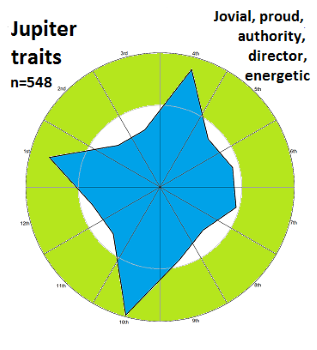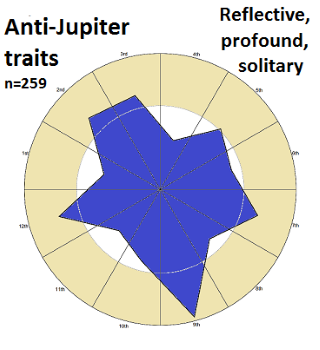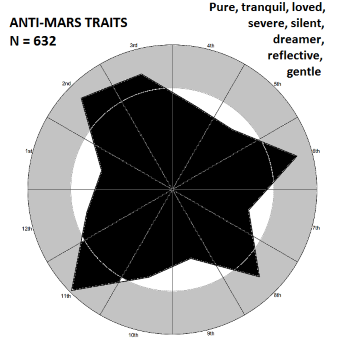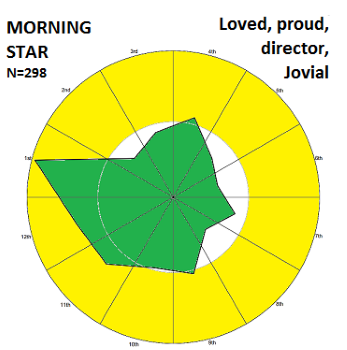Re-evaluating the Gauquelin Data
PAGES
- Introduction
- Expected and Observed planetary frequencies in the Gauquelin professional groups
- The Ertel Enigma
- Report by the French Skeptics, 1982-96
- The Work of Arno Müller
- From the Archives
- Synastry Effects in the Gauquelin 'Heredity' Data
- Poets and the Moon
- Character traits
- Venus
- Database of Character-Traits
- Introvert-Extravert
- Physicians and Sports Champion Data
- Where's the Data?
- Was It Significant?
- A Fourfold Effect
- The Shape of the Gauquelin Professional-Data Effect
- Astro-Psychological Problems
- Françoise and Michel, a Productive Partnership
11. Database of Character-Traits
Here is the first online version of the character-traits - which the Gauquelins insisted were more fundamental, more important, and showed stronger effects, than their professional groups. Were they right? You can check it with this data.
Here is a list of thirty-five character-traits, compiled (as explained in Section 9) from the four data-volumes of sports champions, writers, scientists and actors, which the Gauquelins published in the 1970s. To view this data, right-click on it, copy and paste it into a text file, then upload it onto a spreadsheet program. It contains 4352 lines of birthdata.
The number of times each trait-term was selected from the biographies is called its 'citation count.' Here is a list of these traits, in order of that count:
Simple (318), modest (287), friendly (268), courageous (231), ardent (230), passionate (221), charming (220), active (205), energetic (185), enthusiastic (148), gentle (145), loved (126), authority (125), combative (110), solitary (110), elegant (103), jovial (90), imaginative (85), graceful (81), director (81), noble (79), fantasy (78), profound (77), reflective (76), organizer (71), dreamer (71), seductive (70), proud (67), severe (65), cold (64), vitality (63), tranquil (58), dynamic (57), silent (46), pure (45).
Thus, the trait 'charming' appeared 111 times in biographies of actors, 55 times in those of writers, 28 times in sports biographies and 25 times for scientists, giving a total of 220 citations.
Column 'A' gives the professional group, column 'B' the notional planet - rightly or wrongly - to whom the character-trait 'belongs' and column 'C' has the character-traits, by which the data has been sorted by. Column 'D' gives the names of the eminent persons, and you may wish to sort this database using them, thereby you can see how many character-traits have been selected for each name. (There were many more than here selected, and in San Diego where this trait-research was originally done, at Neil Michelson's ACS Astro-computing Services - with John Addey, the two Gauquelins and Thomas Shanks the computer expert - they had a couple of hundred keywords scored in this manner.) Column 'E' gives the number assigned by the Gauquelins to each line of birth-data, which has been used on the CURA pages http://cura.free.fr/gauq/17archg.html as a reference.
Other columns give birthdata, time and place, then on the right are five columns with numbers 1-12, the Placidus house sectors for each 'Gauquelin' planet. The prediction is, that the four so-called 'Cadent' houses, 3,6,9 and 12 will show either an excess or a deficit for a given planet. In what follows we shall compare that excess, of one-third of the diurnal circle, with the other two-thirds, i.e. the eight other houses.
Jupiter
Let's start with Jupiter. Each of the trait-groups is scored by how many times Jupiter was in one of these four Placidus houses, at the birth of the native. This was expressed as a percentage excess or deficit compared to the other eight. In the language of tradition, we compare how often it appeared in cadent houses, compared to its being in angular or succedent houses.
The highest score here turned out to be the keyword 'Jovial'! This trait included the two French words 'jovial' and 'joyeux.' It scored a 228% excess (48 out of 90 traits) which means, more than a hundred percent above chance level: and that is, the very trait-word named after the planet. Here is a graph showing the distribution for five of the top-scoring Jupiter words:

These five trait-terms Jovial, proud, authority, director, and energetic scored a 78% excess, and are here in sequence according to how well they scored. As to why Jupiter should be the 'authority,' we cannot do better than quote Michel:
Zeus no preside-t-il pas aux autres dieux, du haut de son Olympe?1
In contrast, the next graph shows the three lowest-scoring Jupiter traits. These were reflective, profound and solitary.

One notes the extravert character of Jupiter here, that these introvert traits were scoring lowest (a 25% deficit of the four sectors, compared to the other eight).
This evident working here of anti-Jupiter traits strongly indicates that the Gauquelins were not cheating - in case anyone were to suspect that. N.B., The main evidence against their having cheated, is the fact that they never realised (or showed any sign of realising) that these trait-distributions gave a symmetrical fourfold-structure - nobody in the 20th century except John Addey seems to have realised that (see section 9).
Four times every day, Jupiter moves through one of these Key-sector 'houses.' During those times, people were twice as likely to be born who would later be described in their biographies as 'Jovial.' Clearly, this fact has some far-reaching implications.
Mars
A graph of Mars-traits was shown in section 8. There is little to add, except that the three top-scoring Mars traits give a 100% excess overall. There is nothing subtle about Mars-symbolism. It comes with a 'Pow!'
| Trait | No. of citations | Mars score | %Excess |
|---|---|---|---|
| Combative | 110 | 56 | 207% |
| Vitality | 63 | 32 | 206% |
| Energetic | 185 | 92 | 197% |
Here in contrast are eight of the lowest-scoring Mars-traits (showing a 25% deficit, overall). These low-scores appear as being caused by the Red Planet's daily motion across the sky. These not-Mars qualities help to bring into focus the primary archetype. In both of these anti-trait graphs we see a kind of fourfold structure, only tilted round somewhat.

Saturn
Here are the six top-scoring keywords for Saturn, with the number of trait citations for each, plus how many times Saturn was in one of the four sectors. Then the calculated excess help you see how it works. Ancient keywords, even from textbooks a couple of thousand years old, are here vindicated and validated. Here we may sense 'Old Father Time':
Top Saturn Keywords
| Trait | No. of citations | Saturn score | %Excess |
|---|---|---|---|
| Silent | 46 | 21 | 168% |
| Cold | 64 | 29 | 165% |
| Severe | 65 | 28 | 151% |
| Noble | 79 | 33 | 143% |
| Solitary | 106 | 42 | 131% |
| Profound | 77 | 30 | 127% |
| Total | 437 | 183 | 144% |
Taken together these traits scored a 44% excess. These are generally introvert traits, whereas one notes the opposite concerning the lowest-scoring Saturn-traits, as follows. They all seem extravert - and youthful!
Anti-Saturn (i.e., lowest-scoring) Keywords
| Trait | No. of citations | Saturn score | %Excess |
|---|---|---|---|
| Organiser | 71 | 21 | 84% |
| Ardent | 231 | 68 | 83% |
| Passionate | 221 | 65 | 83% |
| Active | 205 | 60 | 82% |
| Imaginative | 85 | 26 | 78% |
| Combative | 110 | 30 | 75% |
| Seductive | 70 | 19 | 74% |
| Jovial | 90 | 24 | 72% |
| Dynamic | 57 | 14 | 65% |
Venus
Is there a Venus-type? We suggested earlier (Section 10) that a separation between Morning and Evening Star should be made here (The data is thus divided using the Sun-Venus differences in celestial longitude). Here is a graph of the top four traits for the Morning Star. The biographical source-data is almost all male, so female qualities may here be discerned only with some difficulty.
 'Loved' here includes the two French words, amoureux and aimé. That is the number one trait for Venus as Morning Star. The four traits loved, proud, director and jovial Scored a 60% excess. Venus normally shows a big excess in the Placidus houses 1 and 2, on account of it staying near to the Sun, and because non-induced births tend to peak before sunrise.
'Loved' here includes the two French words, amoureux and aimé. That is the number one trait for Venus as Morning Star. The four traits loved, proud, director and jovial Scored a 60% excess. Venus normally shows a big excess in the Placidus houses 1 and 2, on account of it staying near to the Sun, and because non-induced births tend to peak before sunrise.
From the anti-traits ie low-scoring traits for the Morning Star, more of a 'radical-feminist' picture emerges. The numbers are smaller due to the data being split in two. Here are ten lowest-scoring traits:
| 'Anti-traits' | No. of citations | Venus score | %Excess |
|---|---|---|---|
| Tranquil | 34 | 10 | 83% |
| Friendly | 147 | 43 | 82% |
| Gracious | 48 | 14 | 82% |
| Simple | 178 | 52 | 82% |
| Elegant | 52 | 15 | 81% |
| Gentle | 80 | 21 | 71% |
| Cold | 35 | 9 | 69% |
| Silent | 21 | 5 | 62% |
| Dreamer | 38 | 8 | 53% |
Overall, these showed a 22% deficit. Thus, she is not tranquil, nor 'friendly' (this alludes to the two French trait-words aimable and amitié), she is not gracious (French, 'de la grace', having grace), nor simple (NB This has a more positive meaning in the French language, as being straightforward, direct, not duplicitous: 318 of the biographies used it), nor is she elegant, gentle, cold, silent or a dreamer.
These traits could be of someone in charge of an office or company who enjoys being the director. From tradition one might expect a more macho Venus-type to be here present - the strident Bringer of the Dawn, at whose appearance the stars fade away. She was Phosphorus and Lucifer in Greek and Latin, whereas the Evening star was Hesperus and Vespers, and who has heard of them? But, there is remarkably little on this theme and astrology books do not treat them separately. There are no frequent-traits in common, between the Morning and Evening Star.
'Silent' and 'severe' were negative-Mars, but positive for Saturn. 'Pure,' 'tranquil' and 'dreamer' were also negative Mars, but Moon-positive. Thus traits are responding to more than one of the heavenly spheres. These preliminary results suggest it would be worth logging in a larger number of these traits to get a better focus upon how the archetypes are working: or, were working in Europe a century ago. Francoise's book looked at a total of '253 separately-analyzed traits.' (Psychology of the Planets 1982, p.43) She suggested a minimum of fifty counts, for a trait to be included. For example, the trait 'romantic' (34 writers, 11 actors, 1 scientist, zero sports champions) might not score enough to be included.
1. M.G., Les Hommes et les Astres, 1955, p.225.